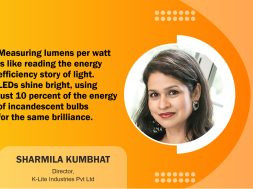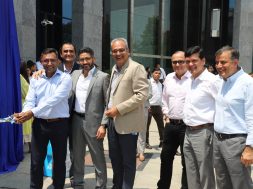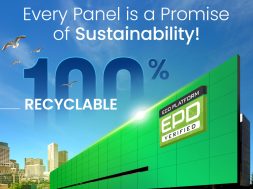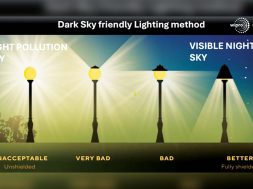Smart and bright LED revolution

This interaction delves into the advancements in LED technology for outdoor use, withstanding harsh climatic conditions, and its implementation in urban infrastructure.
How do LED lights contribute to energy efficiency and cost savings in indoor and outdoor lighting applications?
Getting more light for less money is precisely what LED does. Technically speaking, light output in lumens per watt (the electricity consumption for producing light) indicates energy efficiency. Compared to the conventional incandescent bulb, LEDs use only around 10 percent of energy to produce the equivalent light. Further, the life of LED lights is 25 times that of incandescent bulbs. Hence, LED lights’ energy efficiency and cost savings have proved to be very high in all their applications.
Can you discuss the advancements in LED technology that enhance durability and performance, particularly in harsh environmental conditions such as extreme temperatures and humidity?
LEDs are semiconductor devices. Any indoor or outdoor LED luminaire has three major components: LEDs mounted with their PCBs / COBs with integral LEDs, control electronics such as drivers and the luminaire body (housing). Special design considerations are necessary when discussing durability and performance in harsh environments, such as excessive heat in desert conditions or sub-zero environments, which can occur in Arctic Regions since all these components are thermosensitive. It has been estimated that temperatures exceeding the permissible maximum by 10 degrees will reduce the life span by half. Power dissipation by LEDs themselves is a serious concern, and when this is supplemented by environmental stress factors, such as high humidity or ultraviolet light, it aggravates the worsening situation. Hence, the design procedure has to include the impacts of rapid temperature changes and vibrations in a climatic test chamber. The failure rates of the critical elements are determined to define the life expectancy within the permissible temperature range. Since LEDs, unlike other light sources, do not fail suddenly but emit less and less light over time, their end-of-life is defined as a degradation of the luminosity to 70 percent of the initial value.

LED technology is now very sophisticated. The biggest development potential lies in the further optimisation of intelligent control electronics to create even more efficient, economical and failure-resistant devices. In the not-so-distant future, organic LEDs (OLEDs) will likely become suitable for industrial lighting applications. These light sources are especially suited for interior lighting due to their glare-free emissions.
What are the key considerations when selecting LED lights for outdoor use, especially in regions prone to heavy rainfall, storms, and other weather-related challenges?
When selecting LED lights for outdoor use, IP ratings play a vital role since, with proper IP ratings, the problems expected due to rainfall, storms, and changes other than temperature can be addressed. The existing control electronics have been improved for extreme thermal environments to withstand such conditions comfortably.
How do smart LED lighting systems and controls offer enhanced functionality and adaptability to changing environmental conditions, such as adjusting brightness levels based on ambient light or occupancy?
LEDs are static devices and are ideal for responding without any time delays. The output can be manipulated to meet any requirement. Starting from the light output, light intensity, correlated colour temperature (CCT), lighting brightness tuning to meet the mood and environment, etc., have all become a part of the LED luminaire. Functionality is more to be experienced than said. This is all possible because LED is a static device, and advancements in electronics for smart controls have been developed to a very high level. What will happen when Artificial Intelligence applications are implemented is not known.
Can you provide examples of successful implementations of LED lighting in urban infrastructure projects, such as street lighting, parks, and public spaces, showcasing their benefits in enhancing safety and visibility?
LED lighting in urban infrastructure is being implemented throughout India, particularly in the major cities and identified smart cities. Full-fledged applications of Smart Street lighting with paraphernalia, such as traffic monitoring and control, charging stations for electric vehicles, overall public address system, advertorial displays, etc., are on the way, except for minimal places. However, the advantage of LED streetlights with their control has proved their worth and has come to stay. K-Lite has executed major outdoor projects with LED lights and smart controls in KOTA/ Rajasthan, Varanasi City, Amritsar Golden Temple, etc.
For more information, visit: https://www.klite.in/
Cookie Consent
We use cookies to personalize your experience. By continuing to visit this website you agree to our Terms & Conditions, Privacy Policy and Cookie Policy.









